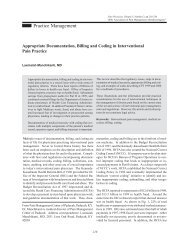ASIPP Practice Guidelines - Pain Physician
ASIPP Practice Guidelines - Pain Physician
ASIPP Practice Guidelines - Pain Physician
You also want an ePaper? Increase the reach of your titles
YUMPU automatically turns print PDFs into web optimized ePapers that Google loves.
Manchikanti et al • <strong>ASIPP</strong> <strong>Practice</strong> <strong>Guidelines</strong><br />
35<br />
EVALUATION AND MANAGEMENT<br />
History<br />
<strong>Pain</strong> history<br />
Medical history<br />
Psychosocial history<br />
Assessment<br />
Physical<br />
Functional<br />
Psychosocial<br />
Diagnostic testing<br />
Impression<br />
Management plan<br />
Alternatives Diagnostic interventions Therapeutic interventional<br />
management<br />
Reevaluation<br />
Persistent pain<br />
New pain<br />
Worsening pain<br />
Repeat comprehensive evaluation<br />
Adequate pain relief and<br />
improvement in functional status<br />
Discharge or maintain<br />
Fig. 2. Suggested algorithm for comprehensive evaluation and management of chronic pain<br />
gia, reflex sympathetic dystrophy, and<br />
intractable pain secondary to carcinoma.<br />
• <strong>Pain</strong> and disability of moderate-to-severe<br />
degree.<br />
• No evidence of contraindications such<br />
as severe spinal stenosis resulting in intraspinal<br />
obstruction, infection, or predominantly<br />
psychogenic pain.<br />
• Responsiveness to prior interventions<br />
with improvement in physical and functional<br />
status for repeat blocks or other<br />
interventions.<br />
• Repeating interventions only upon return<br />
of pain and deterioration in functional<br />
status.<br />
INTERVENTIONAL TECHNIQUES<br />
History<br />
The history of the application of interventional techniques<br />
in pain management dates back to 1901, when epidural<br />
injections for lumbar nerve root compression were reported<br />
(307-309). Since then, substantial advances have been<br />
made in the administration of epidural injections, and a<br />
multitude of other interventional techniques have been<br />
described (310-324). Thus, percutaneous injection techniques<br />
have been distinguished as the favored, and at times<br />
decisive, intervention in the diagnostic and therapeutic<br />
management of chronic painful conditions.<br />
Mechanism<br />
The overall benefit of various types of injection techniques<br />
includes pain relief outlasting by days, weeks, or months<br />
the relatively short duration of pharmacologic action of<br />
<strong>Pain</strong> <strong>Physician</strong> Vol. 4, No. 1, 2001
















